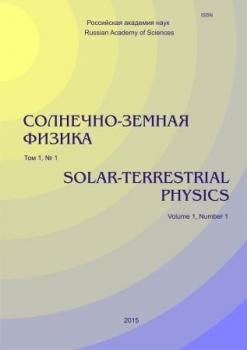с 01.01.2021 по настоящее время
Северо-Восточный федеральный университет им. М.К. Аммосова (доцент)
с 01.01.2018 по 01.01.2021
Якутск, Республика Саха (Якутия), Россия
Якутск, Россия
Якутск, Россия
Представлены результаты моделирования распределения температуры электронов в области F субавроральной ионосферы для разных гелиогеомагнитных условий с учетом магнитосферных потоков тепла. Показано, что для спокойных геомагнитных условий в зимний период в утреннем и вечернем секторах формируются «горячие» зоны повышенной температуры электронов, а для возмущенных — кольцеобразная «горячая» область в интервале 04–06 часов мирового времени в результате притока тепла из магнитосферы вдоль силовых линий геомагнитного поля. Анализ данных, полученных с помощью спутника DE-2, показывает возможность формирования такой зоны в период геомагнитных возмущений.
субавроральная ионосфера, электронная температура, поток тепла, трехмерная модель, кольцевой ток, область F2, зоны повышенной температуры электронов, долготные особенности
INTRODUCTION
In [Koffman, 1984], the effects of electron temperature elevation in the subauroral ionosphere, i.e. “hot spots” (Te≥5000 K), were revealed by experimental data. Numerical simulation of the thermal regime of the high-latitude ionosphere based on Lagrange approach has been discussed in a number of works [Schunk et al., 1986; Klimenko et al., 1991; Mingalev et al., 2002], which analyzed, in particular, the reasons for the formation of hot spots.
In this work, the effect of magnetospheric heat fluxes is studied based on the Euler approach with consideration for the displacement of poles in the electron temperature distribution in the F2 region of the high-latitude ionosphere during a winter period. We use a three-dimensional model of the high-latitude ionosphere (HLI) in Euler variables in terms of its thermal regime [Golikov et al., 2012; Gololobov et al., 2014]. The displacement of geomagnetic and geographic poles, which causes the longitudinal effect in electron density distribution, is taken into account [Kolesnic et al., 1983]. Here, we present the results of space-time distribution of the electron temperature in the F2 region for 05 and 17 UT when the Eastern and Western hemispheres were on the illuminated side. Calculations have been made for winter solstice conditions, solar minimum (F10.7=70), and moderate geomagnetic activity (Kp=3).
1. Golikov I.A., Gololobov A. Ju., Popov V.I. Numerical modelling of heat regime of high-latitudinal ionosphere. Bull. of North-Eastern University. 2012, vol. 9, no. 3, pp. 22-28. (In Russian)
2. Gololobov A.Yu., Golikov I.A., Popov V.I. Modelling of high-latitudinal ionosphere with the account of displacement of geographycal and geomagnetic poles. Bull. of North-Eastern University. 2014, vol. 11, no. 2, pp. 46-54. ( In Russian).
3. Heppner J.P. Empirical model of high electric field. J. Geophys. Res. 1977, vol. 82, no. 7, pp. 1115-1125.
4. Klimenko V.V., Koren'kov Ju.N., Namgaladze A.A., Karpov I.V., Surotkin V.A., Naumova N.M. Numerical modelling of “hot spots” in the Earth’s ionosphere Geomagnetism and Aeronomy. 1991, vol. 31, no. 3, pp. 554-557. (In Russian).
5. Kolesnik A.G., Golikov I.A. Mechanism of a formation of main ionospheric trough in the region F Geomagnetism and Aeronomy. 1983, vol. 23, no. 6, pp. 909-914. (In Russian).
6. Koffman W., Wickwar V.B. Very high electron temperature in the daytime F region at Sondrestrom. Geophys. Res. Lett. 1984, vol. 1, no. 9, pp. 912-922. DOI:https://doi.org/10.1029/GL011i009p00919.
7. Mingalev G.I., Mingaleva V.S. Simulation of the spatial structure of the high-latitude F-region for different conditions of solar illumination of the ionosphere. Proc XXV Annual Seminar “Physics of Auroral Phenomena”, Apatity. 2002, pp. 107-110.
8. Schunk R.W., Sojka J.J., Bowline M.D. Theoretical study of the electron temperature in the high-latitude ionosphere for solar maximum and winter conditions. J. Geophys. Res. 1986, vol. 91, no. A11, pp. 12041-12054.



















